2001 FORD F250 wheel
[x] Cancel search: wheelPage 234 of 288
![FORD F250 2001 Owners Manual •Driving at reasonable speeds (traveling at 88 km/h [55 mph] uses 15%
less fuel than traveling at 105 km/h [65 mph]).
•Revving the engine before turning it off may reduce fuel economy.
•Using th FORD F250 2001 Owners Manual •Driving at reasonable speeds (traveling at 88 km/h [55 mph] uses 15%
less fuel than traveling at 105 km/h [65 mph]).
•Revving the engine before turning it off may reduce fuel economy.
•Using th](/manual-img/11/57804/w960_57804-233.png)
•Driving at reasonable speeds (traveling at 88 km/h [55 mph] uses 15%
less fuel than traveling at 105 km/h [65 mph]).
•Revving the engine before turning it off may reduce fuel economy.
•Using the air conditioner or defroster may reduce fuel economy.
•You may want to turn off the speed control in hilly terrain if
unnecessary shifting between third and fourth gear occurs.
Unnecessary shifting of this type could result in reduced fuel
economy.
•Warming up a vehicle on cold mornings is not required and may
reduce fuel economy.
•Resting your foot on the brake pedal while driving may reduce fuel
economy.
•Combine errands and minimize stop-and-go driving.
Maintenance
•Keep tires properly inflated and use only recommended size.
•Operating a vehicle with the wheels out of alignment will reduce fuel
economy.
•Perform all regularly scheduled maintenance items. Follow the
recommended maintenance schedule and owner maintenance checks
found in your vehicle scheduled maintenance guide.
Conditions
•Heavily loading a vehicle or towing a trailer may reduce fuel economy
at any speed.
•Carrying unnecessary weight may reduce fuel economy (approximately
0.4 km/L [1 mpg] is lost for every 180 kg [400 lb] of weight carried).
•Adding certain accessories to your vehicle (for example bug
deflectors, rollbars/light bars, running boards, ski/luggage racks) may
reduce fuel economy.
•Using fuel blended with alcohol may lower fuel economy.
•Fuel economy may decrease with lower temperatures during the first
12–16 km (8–10 miles) of driving.
•Driving on flat terrain offers improved fuel economy as compared to
driving on hilly terrain.
Maintenance and care
234
ProCarManuals.com
Page 235 of 288
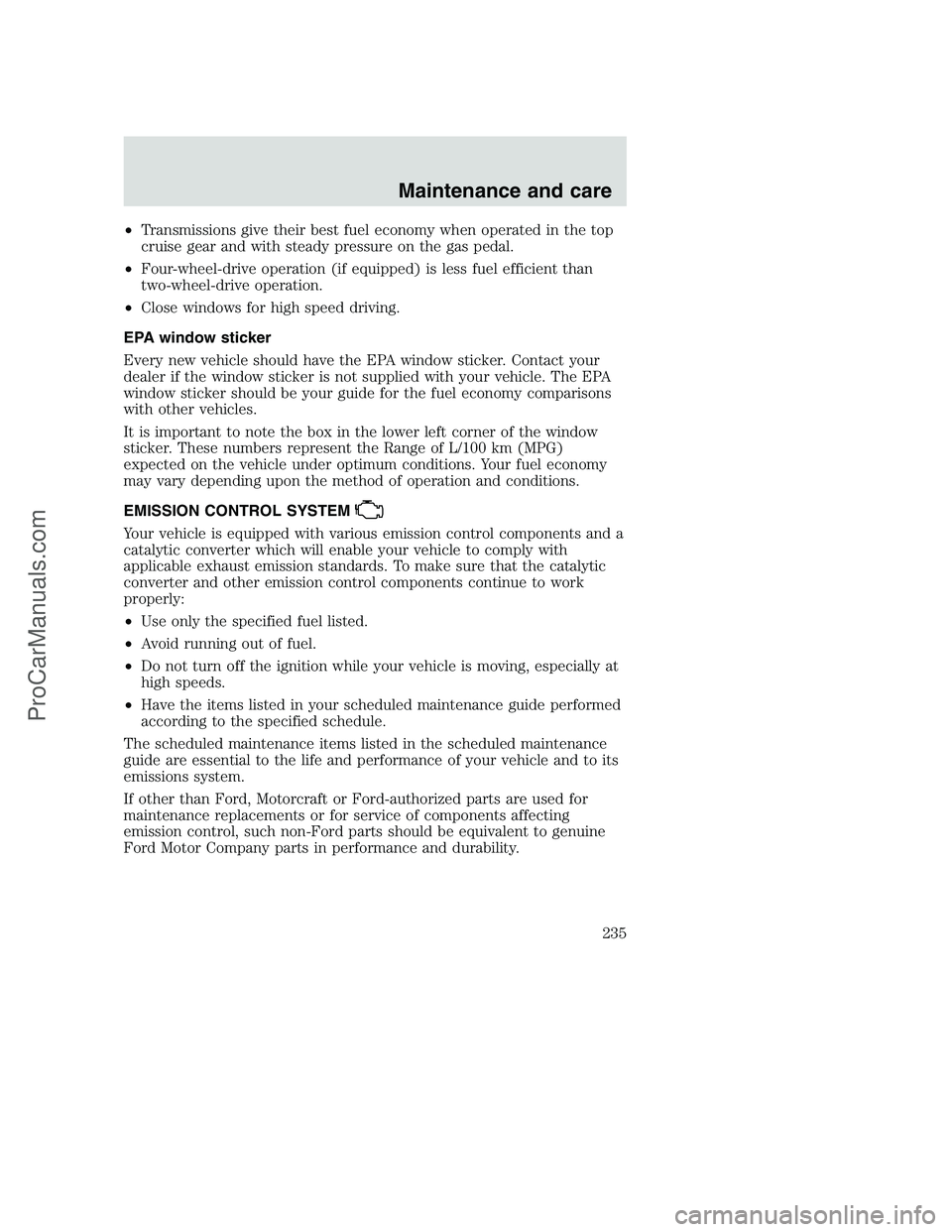
•Transmissions give their best fuel economy when operated in the top
cruise gear and with steady pressure on the gas pedal.
•Four-wheel-drive operation (if equipped) is less fuel efficient than
two-wheel-drive operation.
•Close windows for high speed driving.
EPA window sticker
Every new vehicle should have the EPA window sticker. Contact your
dealer if the window sticker is not supplied with your vehicle. The EPA
window sticker should be your guide for the fuel economy comparisons
with other vehicles.
It is important to note the box in the lower left corner of the window
sticker. These numbers represent the Range of L/100 km (MPG)
expected on the vehicle under optimum conditions. Your fuel economy
may vary depending upon the method of operation and conditions.
EMISSION CONTROL SYSTEM
Your vehicle is equipped with various emission control components and a
catalytic converter which will enable your vehicle to comply with
applicable exhaust emission standards. To make sure that the catalytic
converter and other emission control components continue to work
properly:
•Use only the specified fuel listed.
•Avoid running out of fuel.
•Do not turn off the ignition while your vehicle is moving, especially at
high speeds.
•Have the items listed in your scheduled maintenance guide performed
according to the specified schedule.
The scheduled maintenance items listed in the scheduled maintenance
guide are essential to the life and performance of your vehicle and to its
emissions system.
If other than Ford, Motorcraft or Ford-authorized parts are used for
maintenance replacements or for service of components affecting
emission control, such non-Ford parts should be equivalent to genuine
Ford Motor Company parts in performance and durability.
Maintenance and care
235
ProCarManuals.com
Page 245 of 288
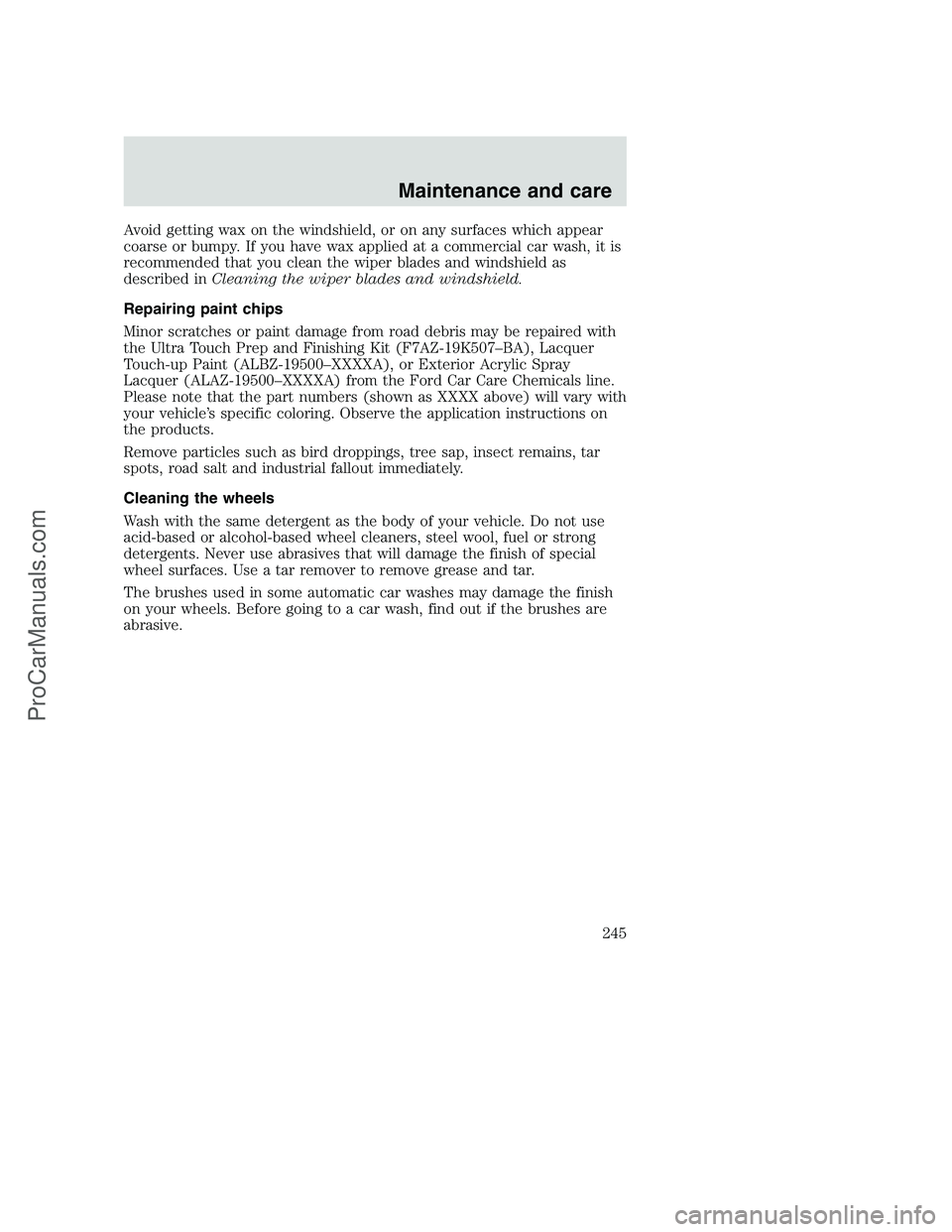
Avoid getting wax on the windshield, or on any surfaces which appear
coarse or bumpy. If you have wax applied at a commercial car wash, it is
recommended that you clean the wiper blades and windshield as
described inCleaning the wiper blades and windshield.
Repairing paint chips
Minor scratches or paint damage from road debris may be repaired with
the Ultra Touch Prep and Finishing Kit (F7AZ-19K507–BA), Lacquer
Touch-up Paint (ALBZ-19500–XXXXA), or Exterior Acrylic Spray
Lacquer (ALAZ-19500–XXXXA) from the Ford Car Care Chemicals line.
Please note that the part numbers (shown as XXXX above) will vary with
your vehicle’s specific coloring. Observe the application instructions on
the products.
Remove particles such as bird droppings, tree sap, insect remains, tar
spots, road salt and industrial fallout immediately.
Cleaning the wheels
Wash with the same detergent as the body of your vehicle. Do not use
acid-based or alcohol-based wheel cleaners, steel wool, fuel or strong
detergents. Never use abrasives that will damage the finish of special
wheel surfaces. Use a tar remover to remove grease and tar.
The brushes used in some automatic car washes may damage the finish
on your wheels. Before going to a car wash, find out if the brushes are
abrasive.
Maintenance and care
245
ProCarManuals.com
Page 247 of 288
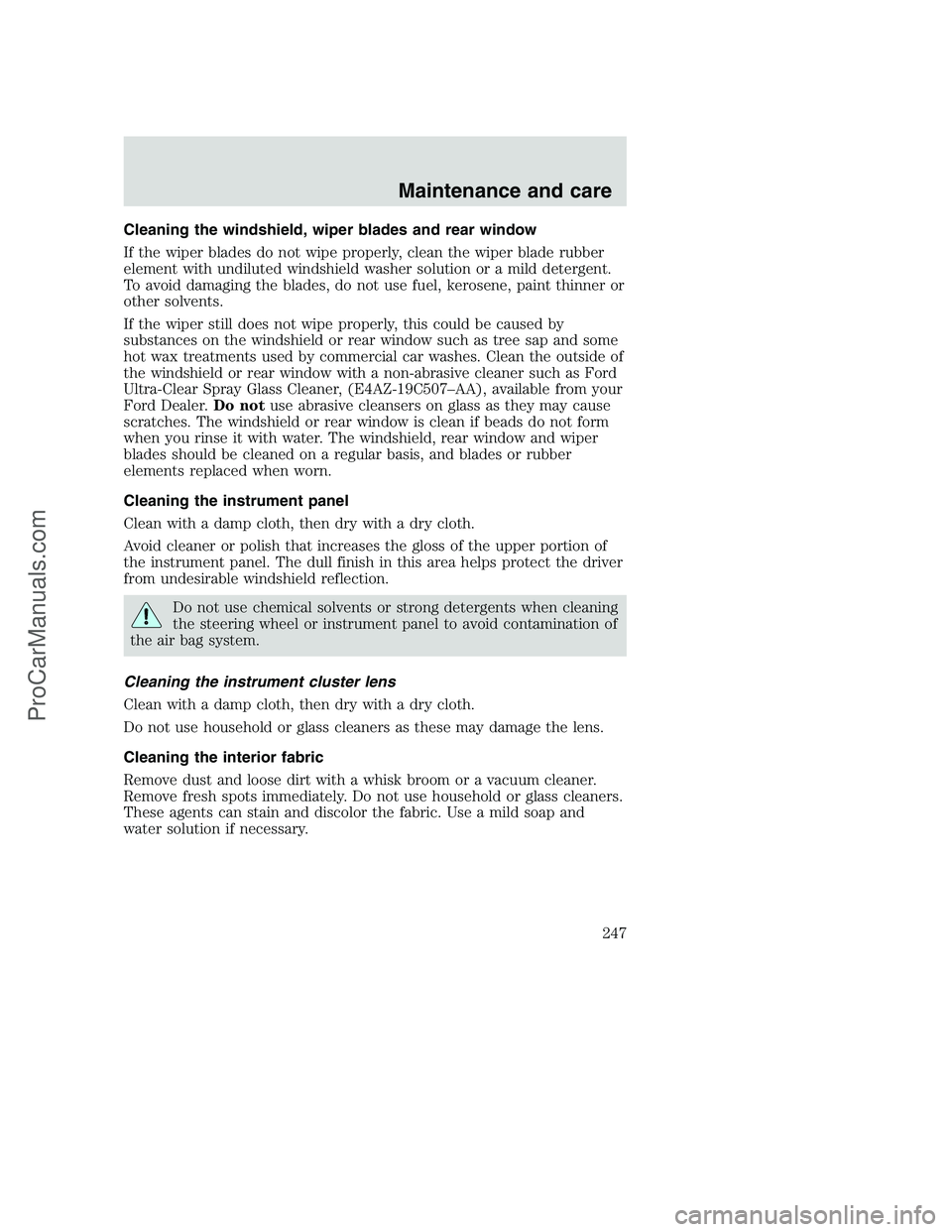
Cleaning the windshield, wiper blades and rear window
If the wiper blades do not wipe properly, clean the wiper blade rubber
element with undiluted windshield washer solution or a mild detergent.
To avoid damaging the blades, do not use fuel, kerosene, paint thinner or
other solvents.
If the wiper still does not wipe properly, this could be caused by
substances on the windshield or rear window such as tree sap and some
hot wax treatments used by commercial car washes. Clean the outside of
the windshield or rear window with a non-abrasive cleaner such as Ford
Ultra-Clear Spray Glass Cleaner, (E4AZ-19C507–AA), available from your
Ford Dealer.Do notuse abrasive cleansers on glass as they may cause
scratches. The windshield or rear window is clean if beads do not form
when you rinse it with water. The windshield, rear window and wiper
blades should be cleaned on a regular basis, and blades or rubber
elements replaced when worn.
Cleaning the instrument panel
Clean with a damp cloth, then dry with a dry cloth.
Avoid cleaner or polish that increases the gloss of the upper portion of
the instrument panel. The dull finish in this area helps protect the driver
from undesirable windshield reflection.
Do not use chemical solvents or strong detergents when cleaning
the steering wheel or instrument panel to avoid contamination of
the air bag system.
Cleaning the instrument cluster lens
Clean with a damp cloth, then dry with a dry cloth.
Do not use household or glass cleaners as these may damage the lens.
Cleaning the interior fabric
Remove dust and loose dirt with a whisk broom or a vacuum cleaner.
Remove fresh spots immediately. Do not use household or glass cleaners.
These agents can stain and discolor the fabric. Use a mild soap and
water solution if necessary.
Maintenance and care
247
ProCarManuals.com
Page 256 of 288
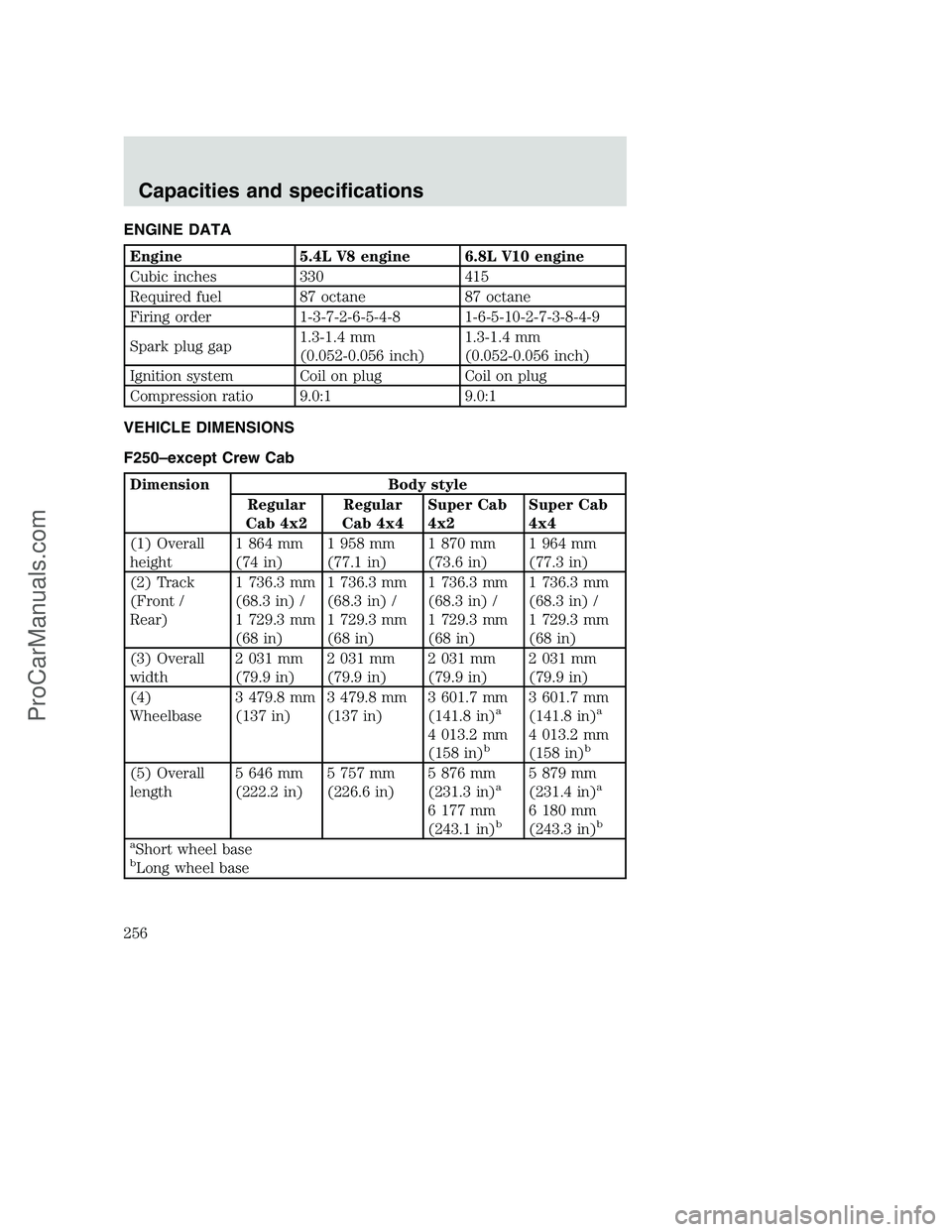
ENGINE DATA
Engine 5.4L V8 engine 6.8L V10 engine
Cubic inches 330 415
Required fuel 87 octane 87 octane
Firing order 1-3-7-2-6-5-4-8 1-6-5-10-2-7-3-8-4-9
Spark plug gap1.3-1.4 mm
(0.052-0.056 inch)1.3-1.4 mm
(0.052-0.056 inch)
Ignition system Coil on plug Coil on plug
Compression ratio 9.0:1 9.0:1
VEHICLE DIMENSIONS
F250–except Crew Cab
Dimension Body style
Regular
Cab 4x2Regular
Cab 4x4Super Cab
4x2Super Cab
4x4
(1) Overall
height1 864 mm
(74 in)1 958 mm
(77.1 in)1 870 mm
(73.6 in)1 964 mm
(77.3 in)
(2) Track
(Front /
Rear)1 736.3 mm
(68.3 in) /
1 729.3 mm
(68 in)1 736.3 mm
(68.3 in) /
1 729.3 mm
(68 in)1 736.3 mm
(68.3 in) /
1 729.3 mm
(68 in)1 736.3 mm
(68.3 in) /
1 729.3 mm
(68 in)
(3) Overall
width2 031 mm
(79.9 in)2 031 mm
(79.9 in)2 031 mm
(79.9 in)2 031 mm
(79.9 in)
(4)
Wheelbase3 479.8 mm
(137 in)3 479.8 mm
(137 in)3 601.7 mm
(141.8 in)
a
4 013.2 mm
(158 in)b
3 601.7 mm
(141.8 in)a
4 013.2 mm
(158 in)b
(5) Overall
length5 646 mm
(222.2 in)5 757 mm
(226.6 in)5 876 mm
(231.3 in)a
6 177 mm
(243.1 in)b
5 879 mm
(231.4 in)a
6 180 mm
(243.3 in)b
a
Short wheel basebLong wheel base
Capacities and specifications
256
ProCarManuals.com
Page 257 of 288
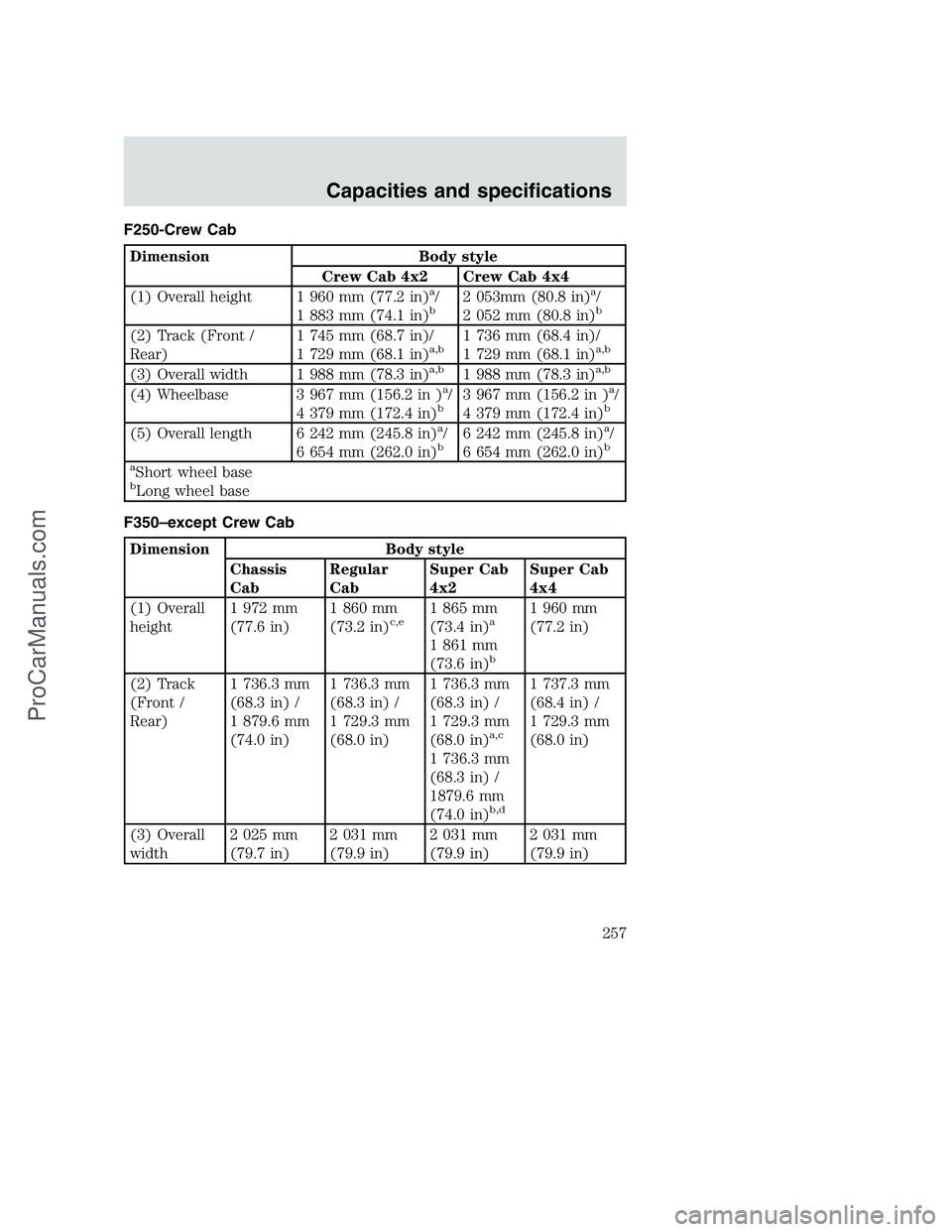
F250-Crew Cab
Dimension Body style
Crew Cab 4x2 Crew Cab 4x4
(1) Overall height 1 960 mm (77.2 in)
a/
1 883 mm (74.1 in)b2 053mm (80.8 in)a/
2 052 mm (80.8 in)b
(2) Track (Front /
Rear)1 745 mm (68.7 in)/
1 729 mm (68.1 in)a,b1 736 mm (68.4 in)/
1 729 mm (68.1 in)a,b
(3) Overall width 1 988 mm (78.3 in)a,b1 988 mm (78.3 in)a,b
(4) Wheelbase 3 967 mm (156.2 in )a/
4 379 mm (172.4 in)b3 967 mm (156.2 in )a/
4 379 mm (172.4 in)b
(5) Overall length 6 242 mm (245.8 in)a/
6 654 mm (262.0 in)b6 242 mm (245.8 in)a/
6 654 mm (262.0 in)b
a
Short wheel basebLong wheel base
F350–except Crew Cab
Dimension Body style
Chassis
CabRegular
CabSuper Cab
4x2Super Cab
4x4
(1) Overall
height1 972 mm
(77.6 in)1 860 mm
(73.2 in)
c,e1 865 mm
(73.4 in)a
1 861 mm
(73.6 in)b
1 960 mm
(77.2 in)
(2) Track
(Front /
Rear)1 736.3 mm
(68.3 in) /
1 879.6 mm
(74.0 in)1 736.3 mm
(68.3 in) /
1 729.3 mm
(68.0 in)1 736.3 mm
(68.3 in) /
1 729.3 mm
(68.0 in)
a,c
1 736.3 mm
(68.3 in) /
1879.6 mm
(74.0 in)
b,d
1 737.3 mm
(68.4 in) /
1 729.3 mm
(68.0 in)
(3) Overall
width2 025 mm
(79.7 in)2 031 mm
(79.9 in)2 031 mm
(79.9 in)2 031 mm
(79.9 in)
Capacities and specifications
257
ProCarManuals.com
Page 258 of 288

Dimension Body style
Chassis
CabRegular
CabSuper Cab
4x2Super Cab
4x4
(4)
Wheelbase3 576.3 mm
(140.8 in)3 479.8 mm
(137.0 in)3 601 mm
(141.8 in)
a/
4 013.2 mm
(158.0 in)
b
3 601 mm
(141.8 in)a/
4 013.2 mm
(158.0 in)
b
(5) Overall
length5 732 mm
(225.7 in)5 754 mm
(226.5 in)5 879 mm
(231.4 in)a/
6 288 mm
(247.6 in)
b
6 291 mm
(247.7 in)
aShort wheel basebLong wheel basecSingle rear wheelsdDual rear wheels
F350-Crew Cab
Dimension Body style
Crew Cab 4x2 Crew Cab 4x4
(1) Overall height 1 929 mm (75.9 in) 2 038 mm (80.2 in)
(2) Track (Front /
Rear)1 745 mm (68.7 in)/
1 729 mm (68.1 in)
a,b1 736 mm (68.4 in)/
1 729 mm (68.1 in)a,b
(3) Overall width 1 988 mm (78.3 in)a,b2 077 mm (79.0 in)a,b
(4) Wheelbase 3 967 mm (156.2 in
)a/4 379 mm (172.4
in)b
3 967 mm (156.2 in
)a/4 379 mm (172.4
in)b
(5) Overall length 6 242 mm (245.8
in)a/6 654 mm (262.0
in)b
6 242 mm (245.8
in)a/6 654 mm (262.0
in)b
a
Short wheel basebLong wheel base
Capacities and specifications
258
ProCarManuals.com
Page 259 of 288
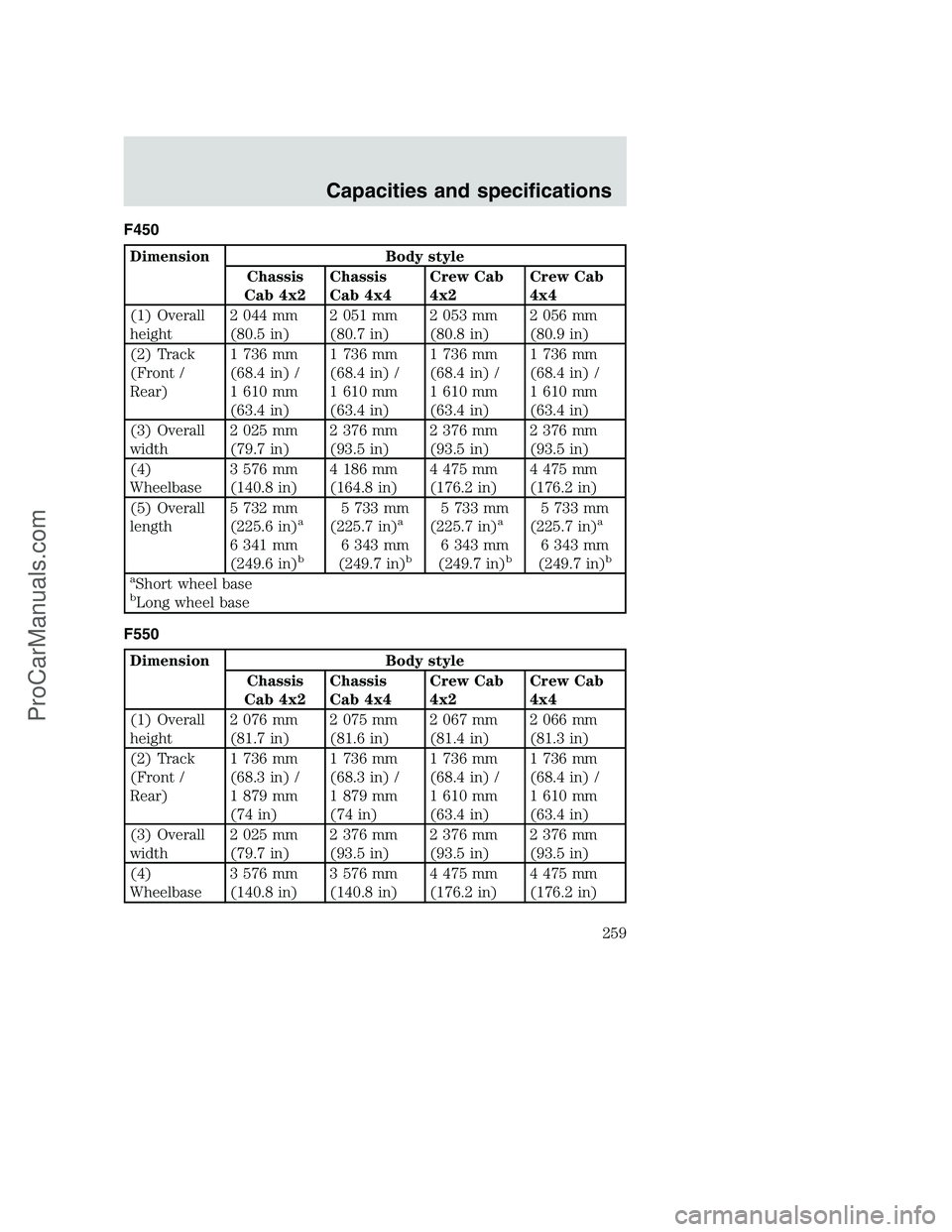
F450
Dimension Body style
Chassis
Cab 4x2Chassis
Cab 4x4Crew Cab
4x2Crew Cab
4x4
(1) Overall
height2 044 mm
(80.5 in)2 051 mm
(80.7 in)2 053 mm
(80.8 in)2 056 mm
(80.9 in)
(2) Track
(Front /
Rear)1 736 mm
(68.4 in) /
1 610 mm
(63.4 in)1 736 mm
(68.4 in) /
1 610 mm
(63.4 in)1 736 mm
(68.4 in) /
1 610 mm
(63.4 in)1 736 mm
(68.4 in) /
1 610 mm
(63.4 in)
(3) Overall
width2 025 mm
(79.7 in)2 376 mm
(93.5 in)2 376 mm
(93.5 in)2 376 mm
(93.5 in)
(4)
Wheelbase3 576 mm
(140.8 in)4 186 mm
(164.8 in)4 475 mm
(176.2 in)4 475 mm
(176.2 in)
(5) Overall
length5 732 mm
(225.6 in)
a
6 341 mm
(249.6 in)b
5 733 mm
(225.7 in)a
6 343 mm
(249.7 in)b
5 733 mm
(225.7 in)a
6 343 mm
(249.7 in)b
5 733 mm
(225.7 in)a
6 343 mm
(249.7 in)b
a
Short wheel basebLong wheel base
F550
Dimension Body style
Chassis
Cab 4x2Chassis
Cab 4x4Crew Cab
4x2Crew Cab
4x4
(1) Overall
height2 076 mm
(81.7 in)2 075 mm
(81.6 in)2 067 mm
(81.4 in)2 066 mm
(81.3 in)
(2) Track
(Front /
Rear)1 736 mm
(68.3 in) /
1 879 mm
(74 in)1 736 mm
(68.3 in) /
1 879 mm
(74 in)1 736 mm
(68.4 in) /
1 610 mm
(63.4 in)1 736 mm
(68.4 in) /
1 610 mm
(63.4 in)
(3) Overall
width2 025 mm
(79.7 in)2 376 mm
(93.5 in)2 376 mm
(93.5 in)2 376 mm
(93.5 in)
(4)
Wheelbase3 576 mm
(140.8 in)3 576 mm
(140.8 in)4 475 mm
(176.2 in)4 475 mm
(176.2 in)
Capacities and specifications
259
ProCarManuals.com